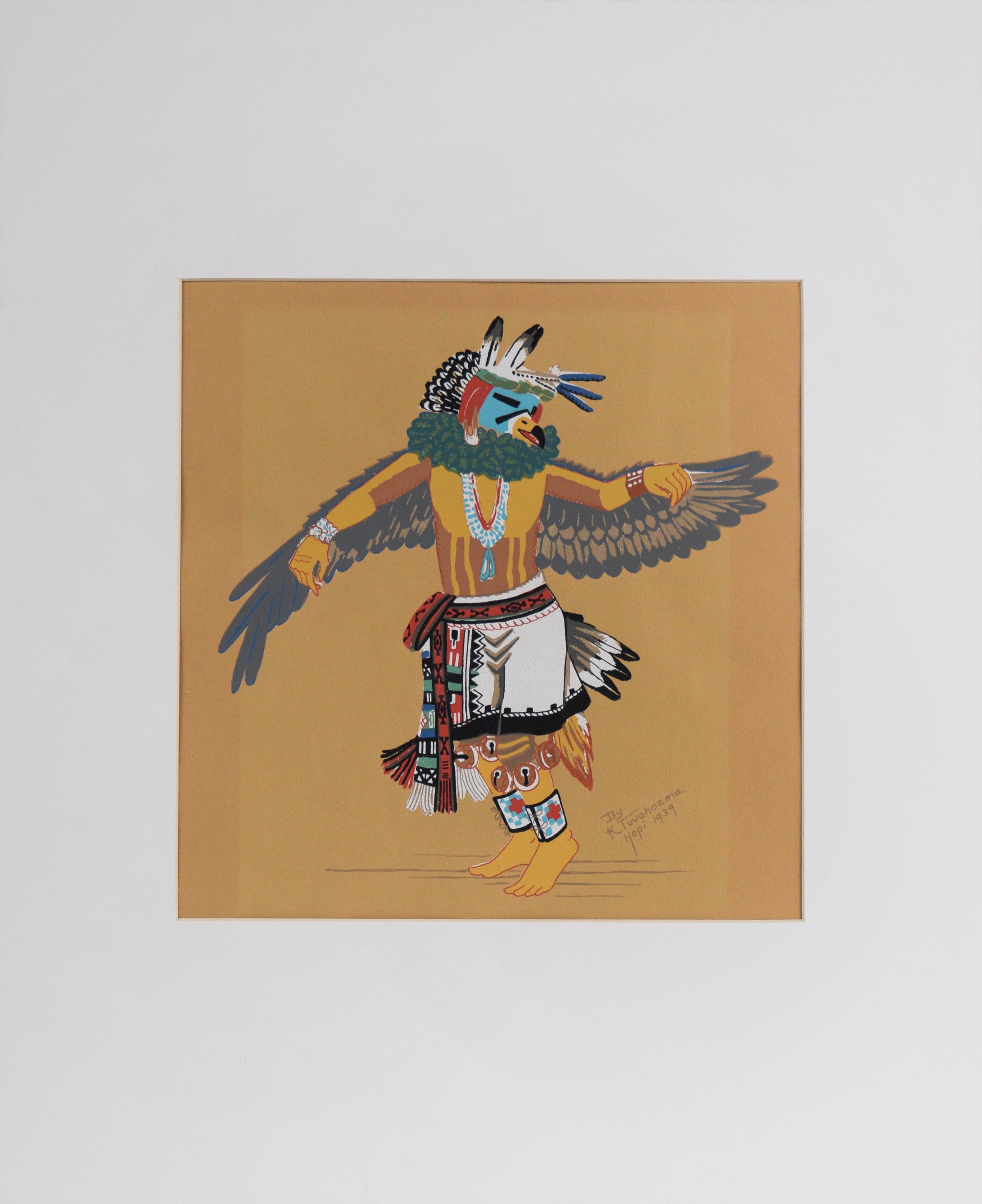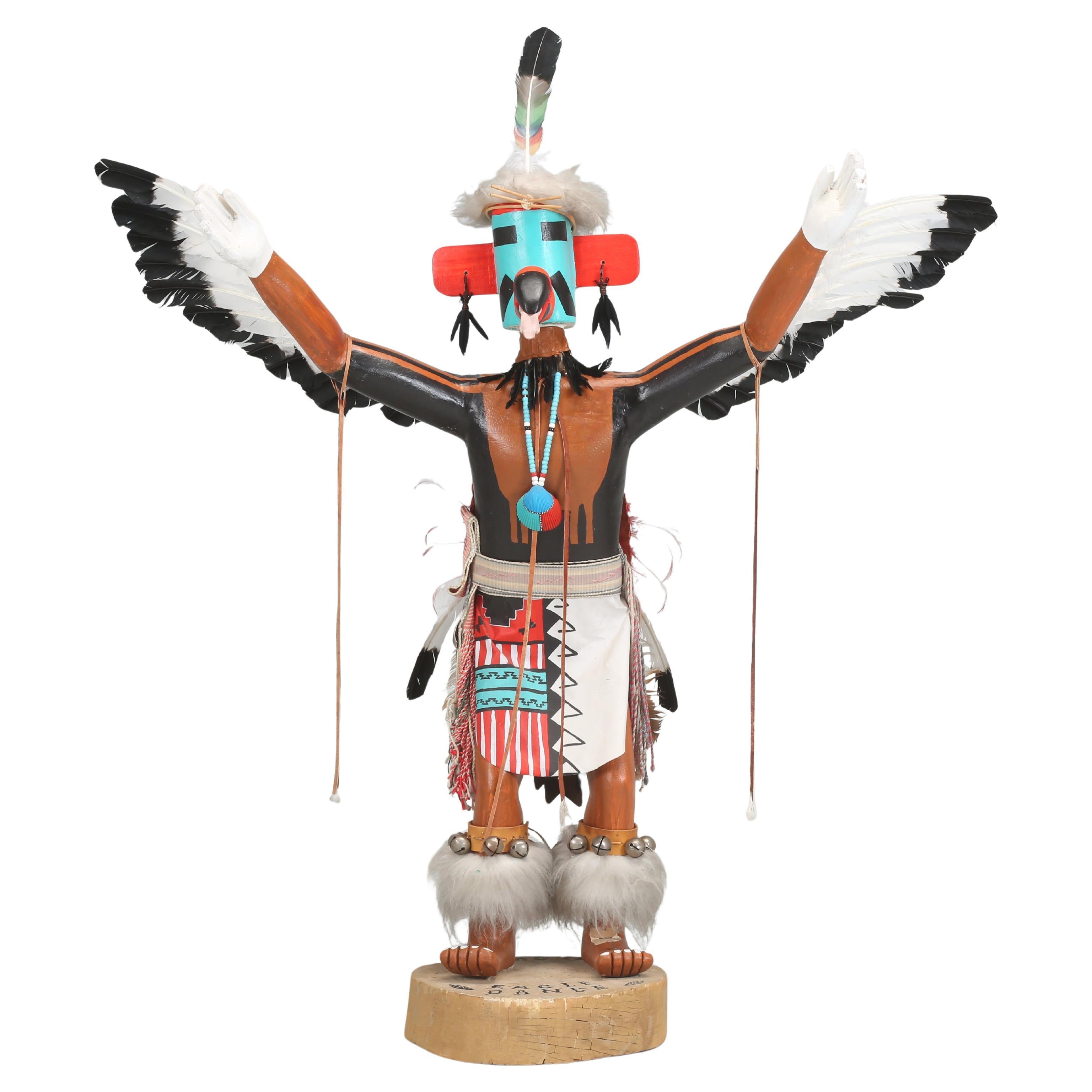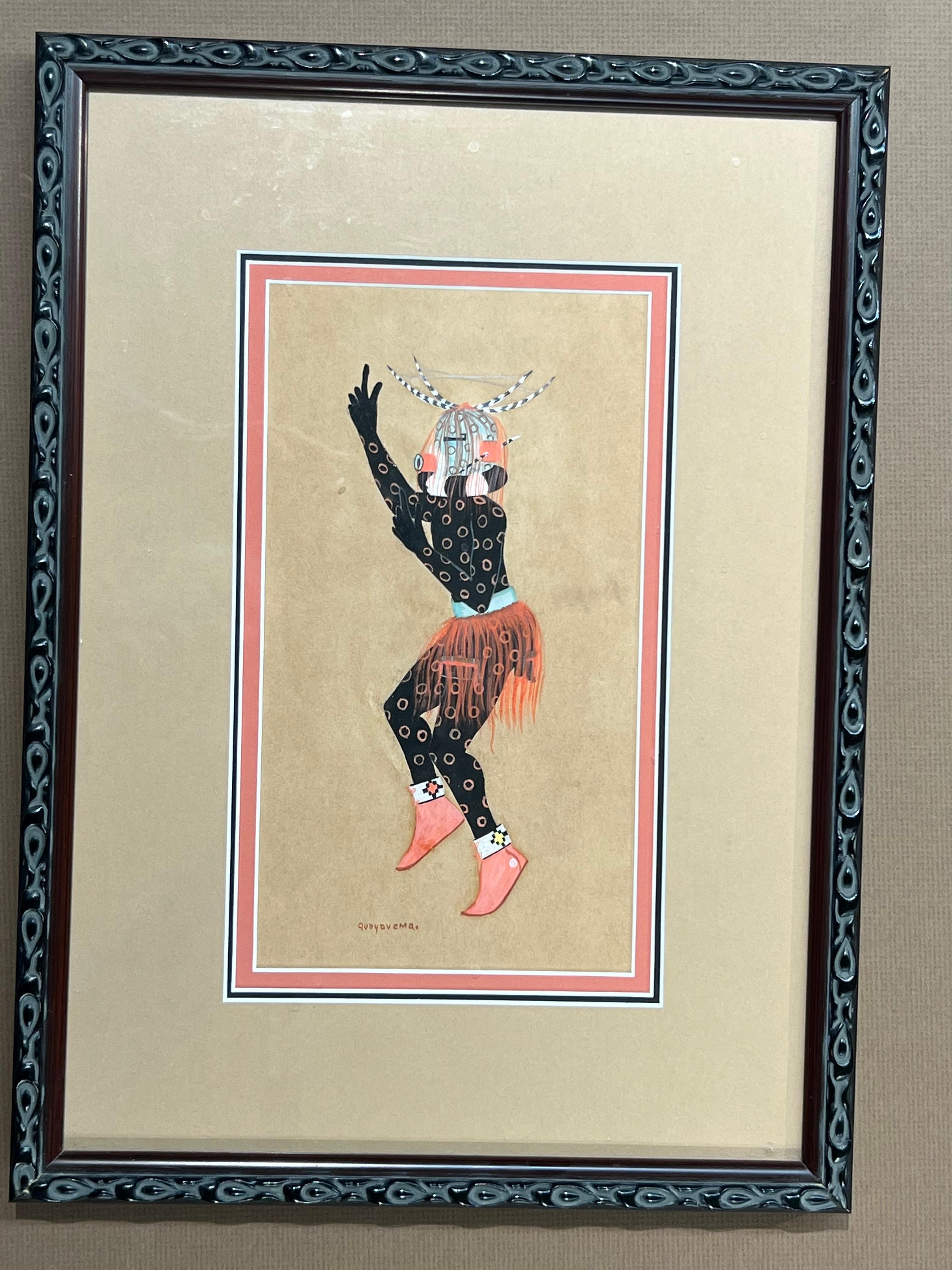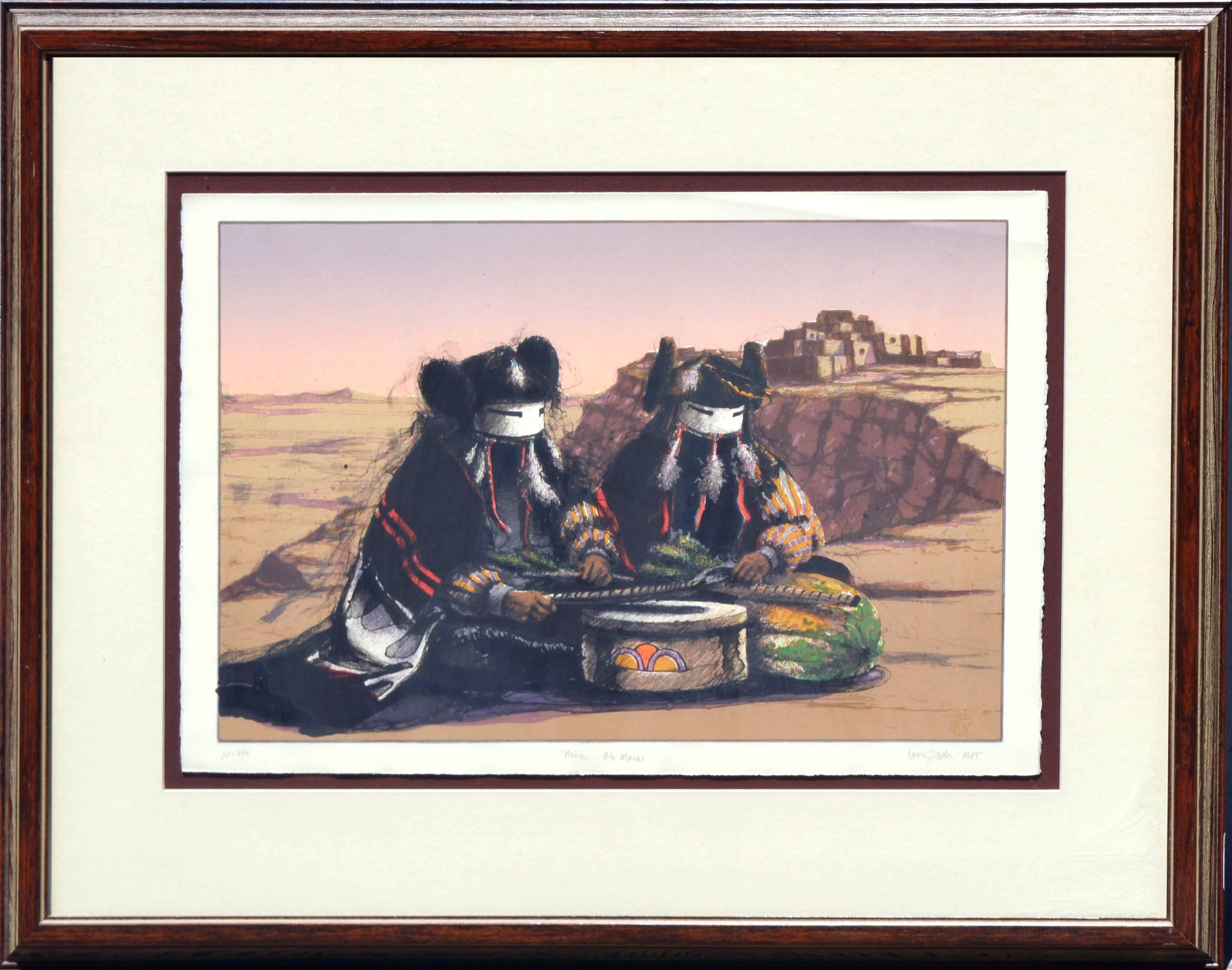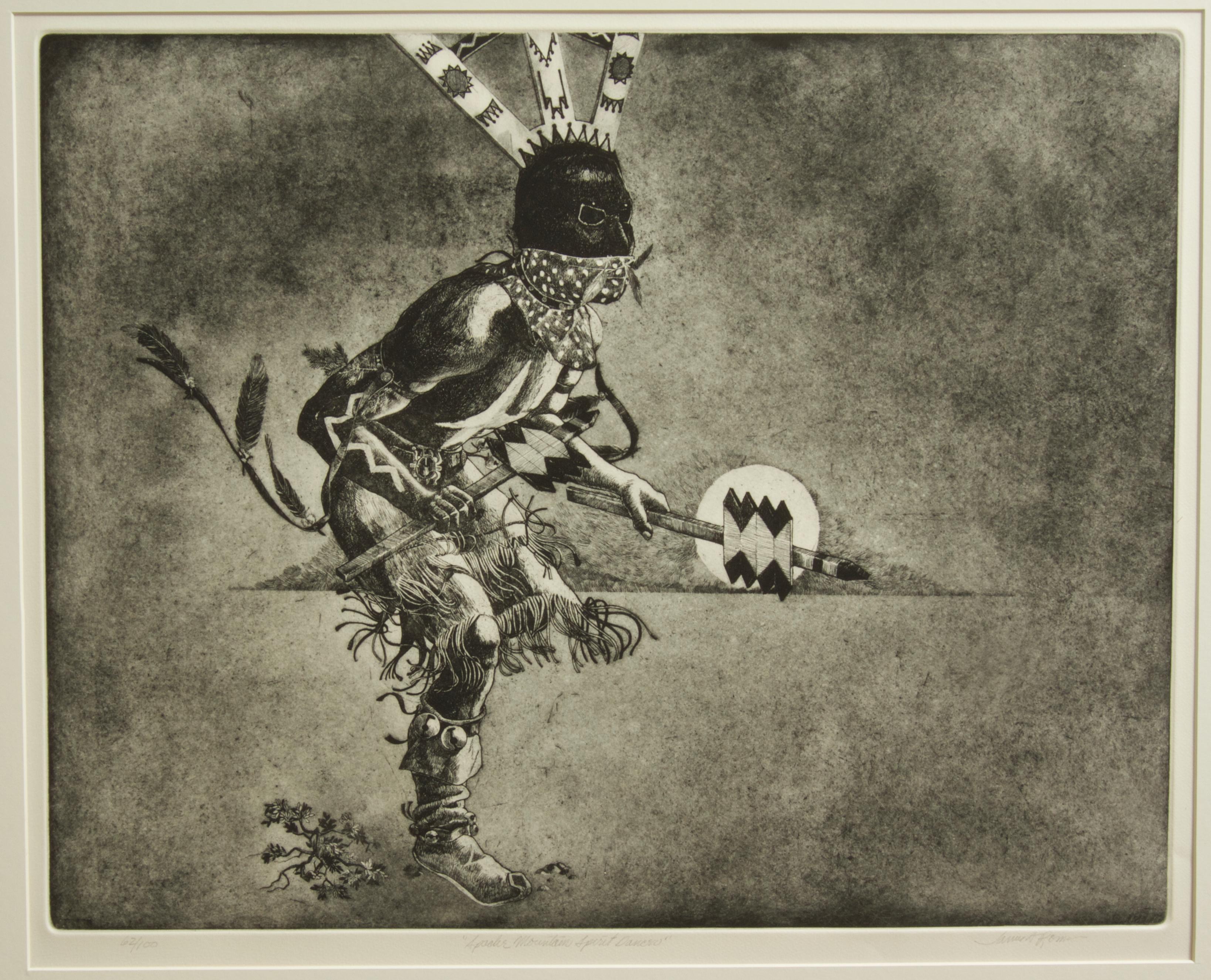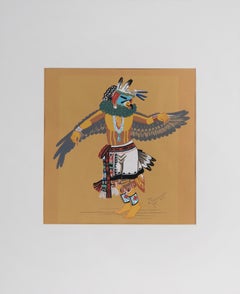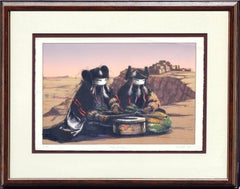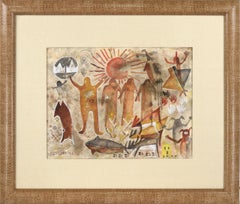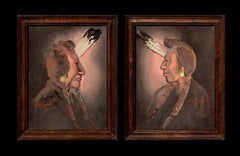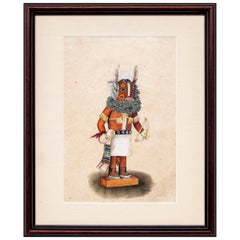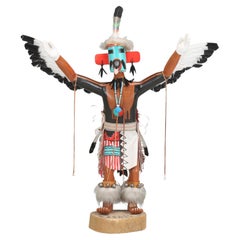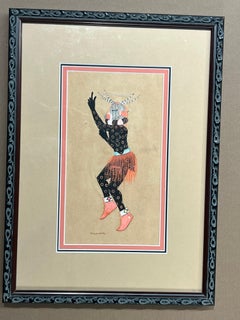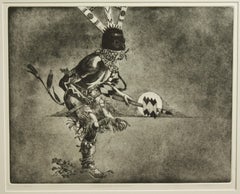Items Similar to Hopi Kachina Dancer by Cliff Bahnimptewa
Want more images or videos?
Request additional images or videos from the seller
1 of 12
Cliff BahnimptewaHopi Kachina Dancer by Cliff Bahnimptewa1978
1978
$2,150
£1,639.99
€1,868.45
CA$3,021.84
A$3,296.75
CHF 1,745.61
MX$39,504.48
NOK 22,231.32
SEK 20,328.89
DKK 13,951.43
About the Item
Detailed and vibrant depiction of a kachina dancer by Cliff Bahnimptewa (Native American, 1937-1984). Signed and dated in the lower right corner. Presented in a new black mat with foamcore backing. Postcard size: 20"H x 15"W
Cliff Bahnimptewa (Native American, 1937-1984) was a Native American artist from the village of Old Oraibi, Hopi Third Mesa. He was a member of the Parro Clan and attended the Phoenix Indian School. Bahnmiptewa learned to carve kachina figures from his grandfather, but was a self-taught painter, and his rich knowledge of his clan and ceremonial affiliations and kachina carvings allowed him to paint with precise detail and authenticity. Bahnimptewa used watercolors and tempera in his kachina paintings, which are more dancing performers than dolls.
Forty eight of Bahnimptewa's paintings were reproduced in Dancing Kachinas, a 1971 publication. His paintings were also featured in a volume Kachinas: A Hopi Artist's Documentary by Barton Wright, 1973.
- Creator:Cliff Bahnimptewa (1937 - 1984, Native American)
- Creation Year:1978
- Dimensions:Height: 24 in (60.96 cm)Width: 20 in (50.8 cm)Depth: 0.25 in (6.35 mm)
- Medium:
- Movement & Style:
- Period:
- Condition:Some tonal ageing to card, as expected for a piece of this age. A few isolated spots of mild foxing.
- Gallery Location:Soquel, CA
- Reference Number:Seller: DBH67891stDibs: LU5428658562
About the Seller
5.0
Platinum Seller
Premium sellers with a 4.7+ rating and 24-hour response times
Established in 1986
1stDibs seller since 2014
3,053 sales on 1stDibs
Typical response time: <1 hour
- ShippingRetrieving quote...Shipping from: Soquel, CA
- Return Policy
More From This Seller
View All"Kachina Eagle Dancer" - 1939 Hopi Serigraph
Located in Soquel, CA
"Kachina Eagle Dancer" - 1939 Serigraph
Serigraph of a Kachina Eagle Dancer by Hopi Pueblo artist Kyrate Tuvahoema (Native American, 1914-1942). The Kachina Eagle Dancer wears a vib...
Category
1930s Impressionist Figurative Paintings
Materials
Paper, Ink
Niman Kachinas - Alo Manas
By Lawrence Fodor
Located in Soquel, CA
Alo Manas by Lawrence Fodor (American, b. 1951). A lithograph of Hopi Medicine Men. Shortly after Summer Solstice each year the Hopi ceremony called the Niman Kachina, also known as “The Going Home of the Kachina.” Presented in a wooden frame. Signed "Larry Fodor...
Category
1980s American Realist Mixed Media
Materials
Lithograph
Pictographs and Symbols Rain Dance Taos Society of Artists Taos New Mexico
Located in Soquel, CA
Pictographic scene by Charles Stewart (American, 1922-2011). There are several figures in the center of the piece, one of which has raised hands, as if to praise the sun above them. Surrounding the figures are symbols reminiscent of Neolithic art - spirals, handprints, and animal symbols.
Signed "C. Stewart , T. S (for Taos Society of Artists)." in the lower left corner.
Presented in a wood frame with vinyl faux-lizard skin wrapping, and a linen mat.
Image size: 16.5"H x 21"W
Charles C. Stewart (1922-2011) was born in Toledo, Ohio. From an early age he had a natural talent for the arts, so much so that during his school years, his teachers encouraged him to take classes at the Toledo Museum. He studied there for eight years.
During World War II, he served with the tank destroyers in five campaigns. When he returned from the war, he studied art and sculpture at the Art Student's League in New York. He then went to Mexico for eight months to study and paint. While in Mexico, he fell in love with the country, its people and arts, vowing one day to return and live.
In 1947, Stewart moved to Taos, New Mexico to start his career. He opened a frame shop and small studio and studied at the Taos Valley Art School under Louis Ribak. In 1949, he opened his own gallery. He taught art and sculpture at the Taos Art Association and at Philbrook Art Center in Tulsa, Oklahoma, as well as teaching private students. He built three homes in Taos, the last of which is known as the "Stewart House." The "Stewart House" was written up in the New Mexico Magazine in an article entitled "The House That Chuck Built" by Tricia Hurst
In late 1984, Stewart and his wife, Mary Lou, were exploring the Baja in Mexico and ended up at "Land's End," a small fishing village on the Sea of Cortez called Cabo San Lucas...
Category
Late 20th Century Contemporary Figurative Paintings
Materials
Paper, Acrylic
Pair of Vintage Native American Portraits
Located in Soquel, CA
Pair of two vintage portraits of Native American figures, one older and one younger, in profile with braids and headdresses by Victor S. ...
Category
1960s American Impressionist Figurative Paintings
Materials
Canvas, Oil, Cardboard
$700 Sale Price
20% Off
Mayan Inspired Abstracted Figurative
Located in Soquel, CA
Stunning contemporary painting of Mayan priest by bay area artist C. Udesen (American 20th C) with impressive costume surrounded with Mayan iconography in...
Category
Early 2000s Contemporary Figurative Paintings
Materials
Canvas, Oil
$3,200 Sale Price
20% Off
Mid Century Abstract Figurative -- Navajo Hunters
By Erle Loran
Located in Soquel, CA
Dynamic, mid century multi colored abstract by Erle Loran (American, 1905-1999). Depicts a group of hunters and their horses participati...
Category
1960s Abstract Expressionist Abstract Paintings
Materials
Gouache, Archival Paper
You May Also Like
Vintage Hand-Colored Lithograph of Kachina Doll by Artist Swankar Hanumann
Located in Denver, CO
This vintage hand-colored lithograph by artist Swankar Hanumann depicts a traditional Kachina (Katsina) doll, a central figure in Hopi and Pueblo ceremonial traditions. The doll is s...
Category
20th Century American Native American Paintings
Materials
Paper
Massive Five Foot Tall Navajo Eagle Dancer Kachina Doll signed "by GUY V.Y."
Located in BENSENVILLE, IL
Massive Five Foot Tall Navajo Kachina Doll is signed "by GUY V.Y." on the base, and titled "Eagle Dance" Guy Yazzie and his wife Pearl Zonnie Chee Horseherder Yazzie had at least 8-c...
Category
Vintage 1970s American Folk Art Native American Objects
Materials
Leather, Wood, Feathers
Corn Kachina, by Riley Sunrise, Quoyavema, Hopi, Kachina, Dancer, painting
Located in Santa Fe, NM
Corn Kachina, by Riley Sunrise, Quoyavema, Hopi, Kachina, Dancer, painting
Artist Signature - Riley Sunrise (1914-2006) Quoyavema “Another of the earlier Hopi artists, Riley Sunrise (Quoyavema) worked with Fred Kabotie and Waldo Mootzka in illustrating John Louw Nelson’s Rhythm for Rain. He is also known as Quoyavema or Kwayeshva, according to Nelson. His paintings are comparable to Fred Kabotie’s, with some of them showing more action and most of them revealing less detail. Sunrise is represented in the collections of the Denver Art Museum, Gilcrease Institute (Tulsa), and the Southwest Museum. The Museum of the American Indian in New York has an extensive collection of his paintings of native Hopi dances.” (Clara Lee Tanner: Southwest Indian...
Category
1940s Tribal Figurative Paintings
Materials
Paint, Paper
Apache Mountain Spirit Dancer
Located in Phoenix, AZ
SHIPPING CHARGES INCLUDE SHIPPING, PACKAGING & **INSURANCE**
Apache Mountain Spirit Dancer
James Rome
Etching 62/100
Image: 21.75 x 27.5 inches
Paper: 25 x...
Category
1980s Contemporary Figurative Prints
Materials
Etching
Deer Dance, painting by Tonita Pena, Santa Fe, Cochiti, Pueblo, male, female
Located in Santa Fe, NM
Deer Dance, painting by Tonita Pena, Santa Fe, Cochiti, Pueblo, male, female
Tonita Peña (born 1893 in San Ildefonso, died 1949 in Kewa Pueblo, New Mexico) was born as Quah Ah (meaning white coral beads) but also used the name Tonita Vigil Peña and María Antonia Tonita Peña. Peña was a renowned Pueblo artist, specializing in pen and ink on paper embellished with watercolor. She was a well-known and influential Native American artist and art teacher of the early 1920s and 1930s.
Tonita Peña was born on May 10, 1893, at San Ildefonso Pueblo, to Ascensión Vigil Peña and Natividad Peña of San Ildefonso Pueblo, New Mexico. When she was 12, her mother and younger sister died, as a result of complications due to the flu. Her father was unable to care for her and she was taken to Cochití Pueblo and was brought up by her aunt Martina Vigil Montoya, a prominent Cochití Pueblo potter. Peña attended St. Catherine Indian School in Santa Fe.
Edgar Lee Hewett, an anthropologist involved in supervising the nearby Frijoles Canyon excavations (now Bandelier National Monument) was instrumental in developing the careers of several San Ildefonso “self-taught” artists including Tonita Peña. Hewett purchased Peña's paintings for the Museum of New Mexico and supplied her with quality paint and paper. Peña began gaining more notoriety by the end of the 1910s selling an increasing amount of her work to collectors and the La Fonda Hotel. Much of this early work was done of Pueblo cultural subject matter, in a style inspired by historic Native American works, however, her use of an artist's easel and Western painting mediums gained her acceptance among her European-American contemporaries in the art world. At the age of 25, she exhibited her work at museums and galleries in the Santa Fe and Albuquerque area.
In the early 1920s, Tonita did not know how much her painting sold for at the Museum of New Mexico, so she wrote letters to the administrators because a local farmer was worried that she got paid too little.
In the 1930s Peña was an instructor at the Santa Fe Indian School and at the Albuquerque Indian School and the only woman painter of the San Ildefonso Self-Taught Group, which included such noted artists as Alfonso Roybal, Julian Martinez, Abel Sánchez (Oqwa Pi), Crecencio Martinez, and Encarnación Peña. As children, these artists attended San Ildefonso day school which was part of the institution of the Dawes Act of 1887, designed to indoctrinate and assimilate Native American children into mainstream American society.
In 1931, Tonita Peña exhibited at the Exposition of Indian Tribal Arts which was presented at the Grand Central Art Galleries in New York City. Works from this exhibition were shown at the 1932 Venice Biennial. That year is the only time Native American artists have shown in the official United States pavilion at that biennial, and Tonita Peña's paintings were part of that exhibition.[1 Her painting Basket Dance, that had shown in the Venice Biennial was acquired by the Whitney Museum of American Art in New York for $225. This was the highest price paid up to this time for a Pueblo painting...
Category
1940s Tribal Figurative Drawings and Watercolors
Materials
Paint, Paper
"Two Pueblo Dancers, Santa Clara" Pablita Velarde, New Mexico Native American
Located in New York, NY
Pablita Velarde
Two Pueblo Dancers, Santa Clara, 1993
Signed and dated lower right
Casein on paper
7 1/2 x 7 1/4 inches
Provenance
Adobe Gallery, New Mexico
Private Collection, Texa...
Category
1990s American Modern Figurative Paintings
Materials
Paper, Casein
